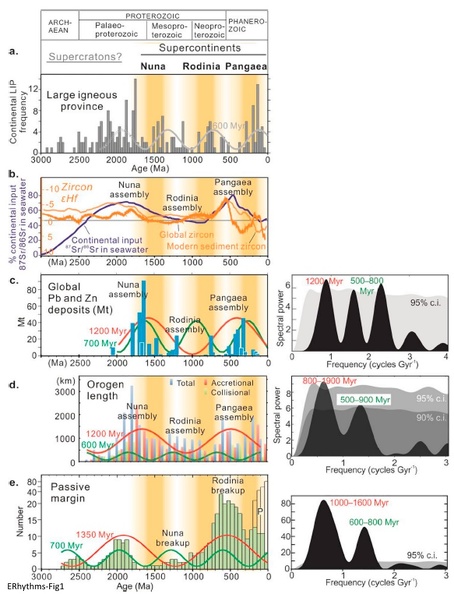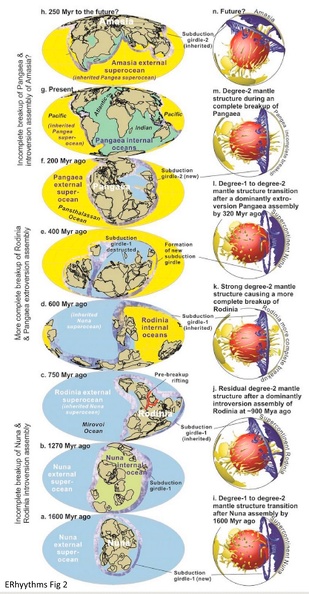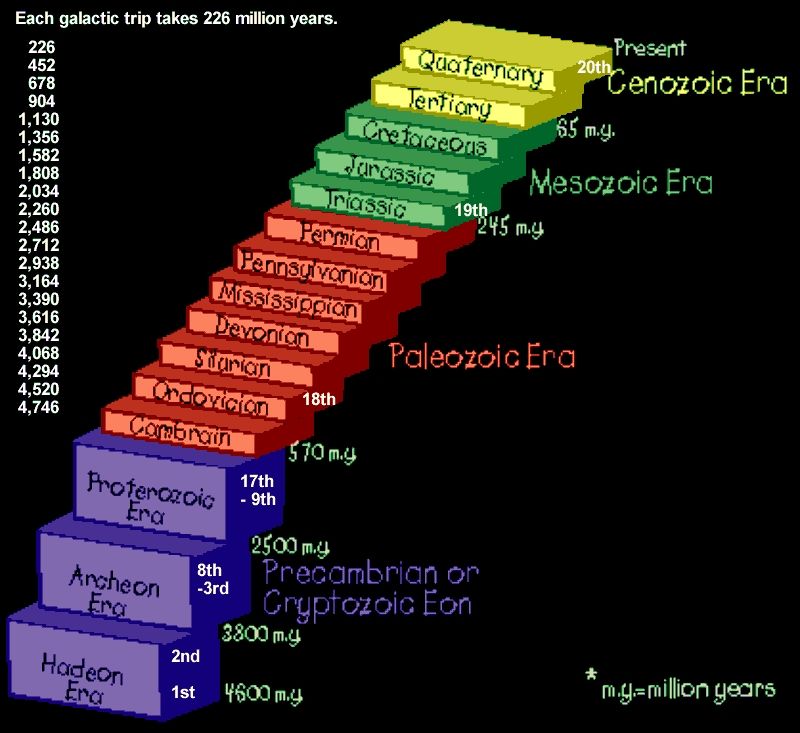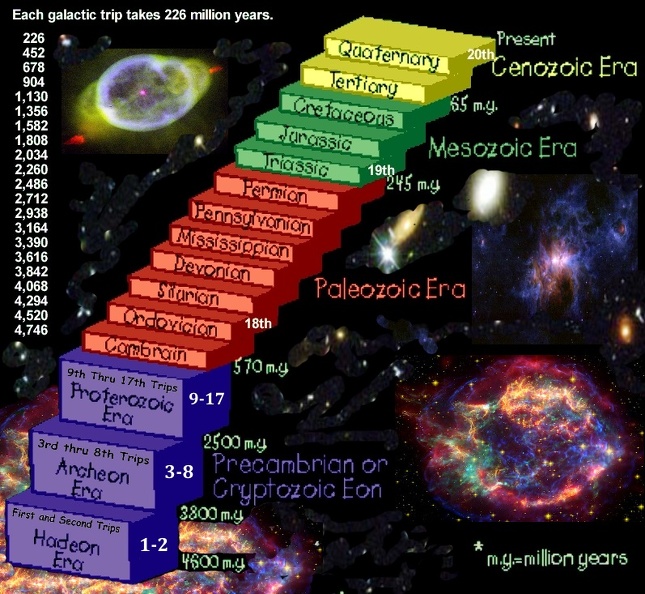Post by 1dave on Feb 4, 2019 22:40:33 GMT -5
Super Continents must be surrounded by super Oceans.
Thanks to grumpybill for directing me to:
wattsupwiththat.com/2019/02/03/study-finds-billion-year-superocean-cycles-in-earths-history/
Which leads to:
reader.elsevier.com/reader/sd/pii/S0301926819300166?token=C9680D6BB9000FCC0A96E543B3C09EB3A9C853A449EAAD2C74AB9D2AE868F4BBD5F584C83F5CA3590AC5969935C601C3
And some new Scientific jargon -
a supercontinent assembled through introversion (e.g., Rodinia) would form above a weaker mantle downwelling due to both the consumption of smaller and younger internal oceans during continental assembly and the partial survival of the degree-2 mantle structure inherited from the previous supercontinent (Fig. 2a–c and j). As a consequence of assembly by introversion over a relatively weak mantle downwelling and inherited circum-supercontinent subduction girdle, the subsequent formation of the superplume beneath the supercontinent (Li et al., 2008; Zhong et al., 2007) is expected to occur sooner than the case of extroversion assembly (Fig. 2j–k vs. Fig. 2l–m), leading to a more complete supercontinent breakup.
We further hypothesize that when a supercontinent assembles predominantly through extroversion (e.g., Pangaea), the total consumption of the previous external superocean, such as the destruction of the Rodinian external superocean during Pangaean assembly (Fig. 2c–f), leads to the destruction of the existing subduction girdle (girdle-1 in Fig. 2a–d, i–k) and the formation of a large and stronger mantle super-downwelling under the new supercontinent (Zhong et al., 2007) due to the subduction of large and numerous oceanic slabs as the supercontinent assembles (Fig. 2l; such a global mantle convection pattern involving a single mantle super-upwelling is commonly known as degree-1 mantle convection structure).
These processes combine to produce a total mantle reorganisation through the loss of the existing degree-2 mantle structure (Fig. 2k–l; in a degree-2 mantle structure there are two opposing mantle upwelling bisected by a subduction girdle, as in Fig. 2k). A newly-formed circumsupercontinent subduction girdle (Fig. 2f, l) would change the dominantly degree-1 mantle structure (Fig. 2l) into a degree-2 mantle structure (Fig. 2m), leading to the subsequent breakup of the supercontinent (Fig. 2m).
According to the “3. orthoversion” model, a supercontinent aggregates over the subduction girdle approximately 90° away from the centroid of its predecessor (Mitchell et al., 2012), regardless whether it assembles predominantly through introversion or extroversion.

Fig. 1. Records of Earth’s supercycles.
(a) The supercontinent cycle (Nuna, Rodinia and Pangaea) since 2000 Myr ago, coupled to a slightly phase-shifted ∼600 Myr plume frequency (superplume; see Supplementary Information for a discussion about terminology) cycle (Li and Zhong, 2009). Gondwana is not considered a true supercontinent here because it consists only half of all continents at the time, and is therefore regarded a stage-result during the assembly of the true supercontinent Pangaea (Evans et al., 2016). As such, it does not have the same effect in terms of the formation of the degree-2 mantle convection like a true supercontinent (Zhong et al., 2007). Earth before ca. 2000 Myr ago likely operated under a different geodynamic regime, featuring the presence of multiple supercratons instead of a singular supercontinent (Bleeker, 2003). Continental large igneous province record is updated from Prokoph et al. (2004) and Ernst (2014).
(b)–(c) Global Hf isotopes of global zircon (Roberts and Spencer, 2015) and that of modern sediment zircon data based on 7086 data points extracted from the data compilation of Robert and Spencer (2015), Sr isotopes of seawater (Shields, 2007), and abundances of Pb-Zn deposits (Leach et al., 2010) showing a longer wavelength cycle than in panel (a).
(c) – (e) Bandpass filtering of records based on Fast-Fourier transform analyses of global records of Pb and Zn deposits (Leach et al., 2010), orogens (Condie et al., 2017), and passive margins (Bradley, 2008), displaying a dominant 1000–1500 Myr cycle that overpowers and modulates a weaker 600–700 Myr cycle. Analytical methods and results are detailed under section 2 Methods and in the Supplementary Information. The modern sediment zircon Hf data compilation is presented in the Supplementary Information Table S2. Z.X. Li et al.
Precambrian Research 323 (2019) 1–52

Fig. 2. Survival of an external superocean over two supercontinent cycles as evidenced by global palaeogeography over the past 2000 Myr (a–h), and speculated corresponding mantle structures (i–n).
Each major internal or external ocean system is colour-coded throughout the series of reconstructions.
The assembly of Rodinia at 900 Ma (also future Amasia) is shown to be predominantly achieved through the closure of the internal ocean system formed as Nuna at 1400 Ma (or Pangaea at 170 Ma) fragmented (i.e., introversion), whereas the assembly of Pangaea was predominantly accomplished through the closure of the external ocean that surrounded Rodinia (i.e., extroversion).
A dominantly introverted supercontinent assembly inherits the pre-existing subduction girdle and degree-two mantle structure, along with the external superocean outside the subduction girdle (e.g., b–c for Rodinia and g–h for Amasia). A dominantly extroverted supercontinent assembly is accompanied by the destruction of the subduction girdle and the previous external superocean (d–f).
Reconstructions were modified from previous solutions for Nuna (Evans and Mitchell, 2011; Zhang et al., 2012), Rodinia (Li et al., 2008), Pangaea (Li and Powell, 2001), and additionally incorporate long-term constraints on palaeolongitude according to the 90° “orthoversion” rule of the supercontinent cycle (Mitchell et al., 2012).
According to the “orthoversion” model, a supercontinent aggregates over the subduction girdle approximately 90° away from the centroid of its predecessor (Mitchell et al., 2012), regardless whether it assembles predominantly through introversion or extroversion.
The mantle dynamics models were modified from Zhong et al. (Zhong et al., 2007), where Earth’s core is shown in red, mantle upwellings in yellow, and mantle downwellings in blue. The palaeomagnetic poles used for reconstructing the paleogeography are shown Fig. S1 and listed in Supplementary Information Table S1. (For interpretation of the references to colour in this figure legend, the reader is referred to the web version of this article.) Z.X. Li et al.
Precambrian Research 323 (2019) 1–53
Thanks to grumpybill for directing me to:
wattsupwiththat.com/2019/02/03/study-finds-billion-year-superocean-cycles-in-earths-history/
Which leads to:
reader.elsevier.com/reader/sd/pii/S0301926819300166?token=C9680D6BB9000FCC0A96E543B3C09EB3A9C853A449EAAD2C74AB9D2AE868F4BBD5F584C83F5CA3590AC5969935C601C3
And some new Scientific jargon -
1. Introversion - The assembly of Rodinia at 900 Ma (also future Amasia) is shown to be predominantly achieved through the closure of the internal ocean system formed as Nuna at 1400 Ma (or Pangaea at 170 Ma) fragmented (i.e., introversion).
a supercontinent assembled through introversion (e.g., Rodinia) would form above a weaker mantle downwelling due to both the consumption of smaller and younger internal oceans during continental assembly and the partial survival of the degree-2 mantle structure inherited from the previous supercontinent (Fig. 2a–c and j). As a consequence of assembly by introversion over a relatively weak mantle downwelling and inherited circum-supercontinent subduction girdle, the subsequent formation of the superplume beneath the supercontinent (Li et al., 2008; Zhong et al., 2007) is expected to occur sooner than the case of extroversion assembly (Fig. 2j–k vs. Fig. 2l–m), leading to a more complete supercontinent breakup.
2. Extroversion - (the previoussupercontinent turned inside-out through the destruction of the Panthalassa-type superocean). The assembly of Pangaea was predominantly accomplished through the closure of the external ocean that surrounded Rodinia (i.e., extroversion).
We further hypothesize that when a supercontinent assembles predominantly through extroversion (e.g., Pangaea), the total consumption of the previous external superocean, such as the destruction of the Rodinian external superocean during Pangaean assembly (Fig. 2c–f), leads to the destruction of the existing subduction girdle (girdle-1 in Fig. 2a–d, i–k) and the formation of a large and stronger mantle super-downwelling under the new supercontinent (Zhong et al., 2007) due to the subduction of large and numerous oceanic slabs as the supercontinent assembles (Fig. 2l; such a global mantle convection pattern involving a single mantle super-upwelling is commonly known as degree-1 mantle convection structure).
These processes combine to produce a total mantle reorganisation through the loss of the existing degree-2 mantle structure (Fig. 2k–l; in a degree-2 mantle structure there are two opposing mantle upwelling bisected by a subduction girdle, as in Fig. 2k). A newly-formed circumsupercontinent subduction girdle (Fig. 2f, l) would change the dominantly degree-1 mantle structure (Fig. 2l) into a degree-2 mantle structure (Fig. 2m), leading to the subsequent breakup of the supercontinent (Fig. 2m).
According to the “3. orthoversion” model, a supercontinent aggregates over the subduction girdle approximately 90° away from the centroid of its predecessor (Mitchell et al., 2012), regardless whether it assembles predominantly through introversion or extroversion.
We argue that Earth history is fundamentally controlled by the supercontinent cycle modulated by an even longer-wavelength superocean episodes.We argue that Earth history is fundamentally controlled by the supercontinent cycle modulated by an even longer-wavelength superocean episodes.
A B S T R A C T
The supercontinent cycle of episodic assembly and breakup of almost all continents on Earth is commonly
considered the longest period variation to affect mantle convection. However, global zircon Hf isotopic signatures
and seawater Sr isotope ratios suggest the existence of a longer-term variation trend that is twice the
duration of the supercontinent cycle. Here we propose that since ∼2 billion years ago the superocean surrounding
a supercontinent, as well as the circum-supercontinent subduction girdle, survive every second supercontinent
cycle. This interpretation is in agreement with global palaeogeography and is supported by variations
in passive margin, orogen, and mineral deposit records that each exhibits both ∼500–700 million years
periodic signal and a 1000–1500 million years variation trend. We suggest that the supercontinent cycle is
modulated by an assembly that alternates between dominantly extroversion after a more complete breakup, and
dominantly introversion after an incomplete breakup of the previous supercontinent.
The supercontinent cycle of episodic assembly and breakup of almost all continents on Earth is commonly
considered the longest period variation to affect mantle convection. However, global zircon Hf isotopic signatures
and seawater Sr isotope ratios suggest the existence of a longer-term variation trend that is twice the
duration of the supercontinent cycle. Here we propose that since ∼2 billion years ago the superocean surrounding
a supercontinent, as well as the circum-supercontinent subduction girdle, survive every second supercontinent
cycle. This interpretation is in agreement with global palaeogeography and is supported by variations
in passive margin, orogen, and mineral deposit records that each exhibits both ∼500–700 million years
periodic signal and a 1000–1500 million years variation trend. We suggest that the supercontinent cycle is
modulated by an assembly that alternates between dominantly extroversion after a more complete breakup, and
dominantly introversion after an incomplete breakup of the previous supercontinent.

Fig. 1. Records of Earth’s supercycles.
(a) The supercontinent cycle (Nuna, Rodinia and Pangaea) since 2000 Myr ago, coupled to a slightly phase-shifted ∼600 Myr plume frequency (superplume; see Supplementary Information for a discussion about terminology) cycle (Li and Zhong, 2009). Gondwana is not considered a true supercontinent here because it consists only half of all continents at the time, and is therefore regarded a stage-result during the assembly of the true supercontinent Pangaea (Evans et al., 2016). As such, it does not have the same effect in terms of the formation of the degree-2 mantle convection like a true supercontinent (Zhong et al., 2007). Earth before ca. 2000 Myr ago likely operated under a different geodynamic regime, featuring the presence of multiple supercratons instead of a singular supercontinent (Bleeker, 2003). Continental large igneous province record is updated from Prokoph et al. (2004) and Ernst (2014).
(b)–(c) Global Hf isotopes of global zircon (Roberts and Spencer, 2015) and that of modern sediment zircon data based on 7086 data points extracted from the data compilation of Robert and Spencer (2015), Sr isotopes of seawater (Shields, 2007), and abundances of Pb-Zn deposits (Leach et al., 2010) showing a longer wavelength cycle than in panel (a).
(c) – (e) Bandpass filtering of records based on Fast-Fourier transform analyses of global records of Pb and Zn deposits (Leach et al., 2010), orogens (Condie et al., 2017), and passive margins (Bradley, 2008), displaying a dominant 1000–1500 Myr cycle that overpowers and modulates a weaker 600–700 Myr cycle. Analytical methods and results are detailed under section 2 Methods and in the Supplementary Information. The modern sediment zircon Hf data compilation is presented in the Supplementary Information Table S2. Z.X. Li et al.
Precambrian Research 323 (2019) 1–52

Fig. 2. Survival of an external superocean over two supercontinent cycles as evidenced by global palaeogeography over the past 2000 Myr (a–h), and speculated corresponding mantle structures (i–n).
Each major internal or external ocean system is colour-coded throughout the series of reconstructions.
The assembly of Rodinia at 900 Ma (also future Amasia) is shown to be predominantly achieved through the closure of the internal ocean system formed as Nuna at 1400 Ma (or Pangaea at 170 Ma) fragmented (i.e., introversion), whereas the assembly of Pangaea was predominantly accomplished through the closure of the external ocean that surrounded Rodinia (i.e., extroversion).
A dominantly introverted supercontinent assembly inherits the pre-existing subduction girdle and degree-two mantle structure, along with the external superocean outside the subduction girdle (e.g., b–c for Rodinia and g–h for Amasia). A dominantly extroverted supercontinent assembly is accompanied by the destruction of the subduction girdle and the previous external superocean (d–f).
Reconstructions were modified from previous solutions for Nuna (Evans and Mitchell, 2011; Zhang et al., 2012), Rodinia (Li et al., 2008), Pangaea (Li and Powell, 2001), and additionally incorporate long-term constraints on palaeolongitude according to the 90° “orthoversion” rule of the supercontinent cycle (Mitchell et al., 2012).
According to the “orthoversion” model, a supercontinent aggregates over the subduction girdle approximately 90° away from the centroid of its predecessor (Mitchell et al., 2012), regardless whether it assembles predominantly through introversion or extroversion.
The mantle dynamics models were modified from Zhong et al. (Zhong et al., 2007), where Earth’s core is shown in red, mantle upwellings in yellow, and mantle downwellings in blue. The palaeomagnetic poles used for reconstructing the paleogeography are shown Fig. S1 and listed in Supplementary Information Table S1. (For interpretation of the references to colour in this figure legend, the reader is referred to the web version of this article.) Z.X. Li et al.
Precambrian Research 323 (2019) 1–53















